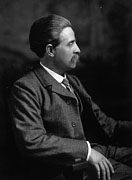Raymond Unwin facts for kids
Quick facts for kids
Sir Raymond Unwin
|
|
|---|---|

Raymond Unwin, c. 1900
|
|
| Born | 2 November 1863 Rotherham, Yorkshire, England
|
| Died | 29 June 1940 (aged 76) |
| Nationality | British |
| Occupation | Engineer and town planner |
| Known for | Improvements in working class housing |
Sir Raymond Unwin (born November 2, 1863 – died June 29, 1940) was an important English engineer, architect, and town planner. He is best known for making homes better for working-class families. A town planner helps design how towns and cities are built, including where houses, parks, and roads go.
Raymond Unwin's Early Life
Raymond Unwin was born in Rotherham, a town in Yorkshire, England. He grew up in Oxford after his father moved there to study. Raymond went to school at Magdalen College School, Oxford. In 1884, he became an engineer's apprentice near Chesterfield.
From a young age, Unwin cared about social issues. He was inspired by the ideas of John Ruskin and William Morris. In 1885, he moved to Manchester. There, he became the secretary of the local Socialist League. This group wanted to improve life for working people. He wrote articles and gave speeches for their cause. He also became good friends with Edward Carpenter, a socialist thinker. Carpenter had ideas for a perfect community, which led to a small commune near Sheffield.
In 1887, Unwin went back to work as an engineer. He helped develop mining towns and other buildings. He also joined the Sheffield Socialist Society.
In 1893, he married Ethel, who was the sister of Richard Barry Parker. In 1896, Unwin and Parker started a business together in Buxton, Derbyshire. They liked a simple, traditional style of building. Their main goal was to make housing better for working-class people. They were also part of the Northern Art Worker's Guild. They were friends with Edgar Wood, a leading architect in the Arts and Crafts Movement in northern England.
Designing Better Communities
Parker and Unwin wrote books, including The Art of Building a Home (1901). They wanted to make the Arts and Crafts Movement popular. This movement focused on handmade items and simple, beautiful designs. Because of their work, thousands of homes were built in their style in the early 1900s.
One of their first projects was in Clayton, Staffordshire, around 1899. It was called the Goodfellow House. Parker and Unwin designed many parts of the house inside. They also planned the large gardens. Later, a famous designer named Clarice Cliff lived in this house, making it well-known.
In 1902, Parker and Unwin were asked to design a model village. This village was for New Earswick near York. It was for Joseph and Benjamin Seebohm Rowntree, who were famous for their chocolate company. The next year, they got a chance to help create Letchworth. This was one of the first "garden cities." A garden city was a new idea for planning towns with green spaces and good housing.
In 1903, they worked on an exhibit called "Cottages Near a Town." In 1904, their plan for Letchworth was chosen. They opened a second office in Baldock. In 1905, Henrietta Barnett asked them to plan a new garden suburb. This area is now known as Hampstead Garden Suburb.
Unwin moved from Letchworth to Hampstead in 1906. He lived there for the rest of his life at a place called Wyldes Farm.
In 1907, a group called Ealing Tenants Limited hired him. They were a cooperative in west London. Unwin helped them develop the Brentham garden suburb.
Unwin joined the Local Government Board in 1914. This was a government department. In 1915, he helped the Ministry of Munitions. He designed villages like Gretna and Eastriggs during World War I. From 1917, he played a big role in the Tudor Walters Committee. This committee studied housing for working-class people. Their report came out in 1919. That same year, Unwin became the Chief Architect for the new Ministry of Health. By the time he retired in 1928, he was the Chief Technical Officer for Housing and Town Planning.
During World War I, Unwin showed how to build homes quickly and cheaply. He made sure they still had good gardens, privacy, and enough space inside. This work greatly influenced the Tudor Walters Committee. Because of this, he shaped much of the public housing built between the two World Wars. His report suggested that new housing areas should be "satellites" on the edge of cities, not full garden cities. In 1929, Unwin became an adviser to the Greater London Regional Planning Committee. He wrote most of their two reports, published in 1929 and 1933.
Unwin was the President of the Royal Town Planning Institute from 1915 to 1916. He was also President of the Royal Institute of British Architects from 1931 to 1933. He was made a knight in 1932, which means he received the title "Sir." In 1933, US President Franklin D. Roosevelt asked for his advice on the New Deal. The New Deal was a series of programs to help the US economy during the Great Depression. In 1936, Unwin became a visiting professor at Columbia University. In 1937, he received the RIBA Royal Gold Medal for architecture. He also received honorary doctorates from the Norwegian Institute of Technology in 1935 and Harvard University in 1937.
Later Life and Legacy
Raymond Unwin passed away on June 29, 1940, in Lyme, Connecticut, at his daughter's home. His great-great-grandson later unveiled a roundabout in his memory in Siddington, Gloucestershire.
See also
In Spanish: Raymond Unwin para niños

